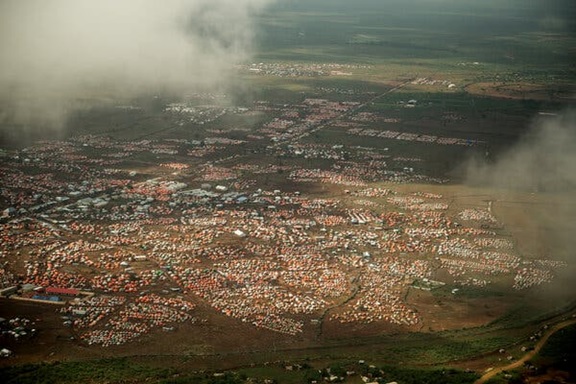
The sea of rag-and-stick tents that spreads in every direction from the hungry, embattled city of Baidoa, in southern Somalia, gives way to sprawling plains controlled by the militants of Al Shabab.
Over 165,000 refugees have streamed into Baidoa since early last year, fleeing the ravages of Somalia’s fiercest drought in 40 years. Among them was Maryam, a 2-year-old girl whose family had lost everything.

The drought withered their crops, starved their animals and transformed their modest farm into a howling dust bowl. They endured a five-day trek to Baidoa, braving Islamist check posts, hoping to reach safety.
But one recent afternoon Maryam, weak from hunger and sickness, began to cough and vomit. Her mother, cradling Maryam in her arms, called for help.Calamity beckons in Somalia, where a combination of extreme weather and extremists is driving the country toward its most serious humanitarian disaster in over a decade. Five seasons of failed rains, linked to climate change, have hit 7.8 million Somalis, 300,000 of whom are experiencing severe starvation.
But weather alone doesn’t create famine, experts say — it takes people, too. The biggest obstacle to a massive relief effort is the presence of Al Shabab, the extremists who dispatch suicide bombers and forcibly recruit children, tax farmers and prevent aid groups from reaching the worst-hit areas.
Somalis are waiting to see if aid experts will formally declare a famine in the coming weeks. Many already fear that history is repeating: Somalia’s last two great famines, in 1992 and 2011, which killed half a million people between them, were also the product of drought supercharged by war.
Designated levels of hunger mean nothing for Maryam, who died just before sunset on Nov. 3. Men from the camp carried her remains, wrapped in a donated shroud, in a quiet procession to a small graveyard on the edge of Baidoa. A small twig with green shoots marks her grave.
Her mother, Nurtay Nurow, remained behind in their tent, mourning the third child she has lost to the drought.
“I felt so helpless,” she said the next day, resigned yet dry-eyed, her two remaining sons sitting silently by her side.
It has been a year since Somalia’s government declared the drought a national emergency, but aid workers say the crisis is now critical. Every minute, on average, a severely malnourished child is admitted to a health facility for treatment. Hospital wards are filling with starving children suffering from measles, pneumonia and other diseases that prey on the weak.
At least 1.1 million people have abandoned their homes for crowded, dirty camps like the ones around Baidoa. The U.N. says it needs an additional $1 billion for emergency food, water and shelter.
Without urgent action, at least 500,000 children will be at risk of death by mid-2023, “a pending nightmare we have not seen this century,” the UNICEF spokesman James Elder said recently.
Kenya and Ethiopia are also victims of the unrelenting two-year drought, which has pushed 21 million people in the Horn of Africa to the brink. But the situation is most acute in Somalia, where a grim confluence of factors has turned a crisis into a catastrophe.
Scientists say that longer and more frequent droughts are a product of climate change caused by the emissions of countries that are far richer than Somalia, which emits practically nothing. In 2019, according to the World Bank, Somalia produced 690 kilotons of carbon emissions — 1/7,000 as much as the United States, which produced 4.8 million kilotons.
Trapped between hostile forces that seem either intangible or invincible, Somalis are shouting for help.
“If these kids don’t get what they need, they are going to die,” said an aid worker, Ali Nur Mohamed, at a feeding center in Baidoa funded by World Vision. Around him, women extended their shawls to collect sachets of a peanut paste that revives starving infants.
“There are shortages of food, of water — of everything,” he said.
Baidoa, once known as the breadbasket of Somalia, has a decades-old association with famine. The skeletal bodies of the dead littered its streets in 1992, when a third of the town’s population starved to death over three months as failed harvests combined with a raging civil war. At the peak of the famine, 15 children died every day.
Read more: Trapped Between Extremist and Extreme Weather, Somalia Braces for Famine
Source: NYTIMES


